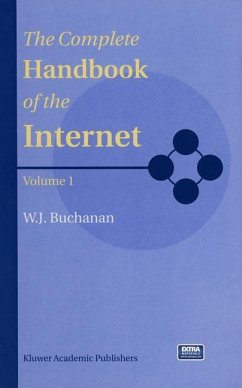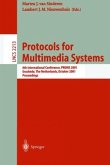B. Buchanan
The Complete Handbook of the Internet
B. Buchanan
The Complete Handbook of the Internet
- Gebundenes Buch
- Merkliste
- Auf die Merkliste
- Bewerten Bewerten
- Teilen
- Produkt teilen
- Produkterinnerung
- Produkterinnerung
The Complete Handbook of the Internet covers all of the recent developments and relevant areas in the Internet Technology. This two volume handbook is divided into ten different sections. The Complete Handbook of the Internet is a complete and essential reference for academics and professionals whom are developing and working with the Internet.
Andere Kunden interessierten sich auch für
![Managing QoS in Multimedia Networks and Services Managing QoS in Multimedia Networks and Services]() Jos‚ Neuman de Souza / Raouf Boutaba (Hgg.)Managing QoS in Multimedia Networks and Services153,99 €
Jos‚ Neuman de Souza / Raouf Boutaba (Hgg.)Managing QoS in Multimedia Networks and Services153,99 €![Multimedia Tools and Applications Multimedia Tools and Applications]() Multimedia Tools and Applications115,99 €
Multimedia Tools and Applications115,99 €![Video Over IP Video Over IP]() Wes SimpsonVideo Over IP103,99 €
Wes SimpsonVideo Over IP103,99 €![Digital Convergence: The Information Revolution Digital Convergence: The Information Revolution]() Digital Convergence: The Information Revolution39,99 €
Digital Convergence: The Information Revolution39,99 €![Protocols for Multimedia Systems Protocols for Multimedia Systems]() Marten J. van Sinderen / Lambert J.M. Nieuwenhuis (eds.)Protocols for Multimedia Systems39,99 €
Marten J. van Sinderen / Lambert J.M. Nieuwenhuis (eds.)Protocols for Multimedia Systems39,99 €![Educating Professionals for Network-Centric Organisations Educating Professionals for Network-Centric Organisations]() Peter Juliff / Tsurayuki Kado / Ben-Zion Barta (eds.)Educating Professionals for Network-Centric Organisations115,99 €
Peter Juliff / Tsurayuki Kado / Ben-Zion Barta (eds.)Educating Professionals for Network-Centric Organisations115,99 €![The World Wide Web and Databases The World Wide Web and Databases]() Dan Suciu / Gottfried Vossen (eds.)The World Wide Web and Databases39,99 €
Dan Suciu / Gottfried Vossen (eds.)The World Wide Web and Databases39,99 €-
-
-
The Complete Handbook of the Internet covers all of the recent developments and relevant areas in the Internet Technology. This two volume handbook is divided into ten different sections.
The Complete Handbook of the Internet is a complete and essential reference for academics and professionals whom are developing and working with the Internet.
The Complete Handbook of the Internet is a complete and essential reference for academics and professionals whom are developing and working with the Internet.
Produktdetails
- Produktdetails
- Verlag: Springer / Springer US / Springer, Berlin
- Artikelnr. des Verlages: 978-1-4020-7290-1
- 2002
- Seitenzahl: 1736
- Erscheinungstermin: 31. Dezember 2002
- Englisch
- Abmessung: 241mm x 160mm x 116mm
- Gewicht: 3183g
- ISBN-13: 9781402072901
- ISBN-10: 1402072902
- Artikelnr.: 22257858
- Herstellerkennzeichnung
- Springer-Verlag GmbH
- Tiergartenstr. 17
- 69121 Heidelberg
- ProductSafety@springernature.com
- Verlag: Springer / Springer US / Springer, Berlin
- Artikelnr. des Verlages: 978-1-4020-7290-1
- 2002
- Seitenzahl: 1736
- Erscheinungstermin: 31. Dezember 2002
- Englisch
- Abmessung: 241mm x 160mm x 116mm
- Gewicht: 3183g
- ISBN-13: 9781402072901
- ISBN-10: 1402072902
- Artikelnr.: 22257858
- Herstellerkennzeichnung
- Springer-Verlag GmbH
- Tiergartenstr. 17
- 69121 Heidelberg
- ProductSafety@springernature.com
Preface. A1: Introduction. A2: Distributed elements. A3: Operating systems.
A4: Processes and scheduling. A5: Distributed processing. A6: Distributed
file systems. A7: Agents. B1: Data communications. B2: Real-time data and
compression. B3: Error coding. B4: RS-232. B5: Modems. C1: Introduction to
networks. C2: Networking types. C3: Ethernet. C4: Network design, switches
and vLANs. C5: Token Ring. C6: FDDI. C7: ATM. C8: HDLC. C9: ISDN. C10:
X.25. C11: Wireless Networks (IEEE 802.11b). D1: IP. D2: TCP/UDP. D3:
SPX/IPX. D4: NetBEUI and NetBIOS. D5: PPP, SLIP and VPN's. D6: TCP/IP
Commands. D7: Socket programming. E1: Routers. E2: Routing protocols. E3:
Security. E4: Router programming and ACLs. E5: Encryption. E6: Public-key
encryption. F1: Electronic mail. F2: WWW and HTTP. F3: SNMP, Wins, Bootp,
DNS and DHCP. F4: FTP/HTTP/Telnet set up and programming. G1: Networking
Operating Systems. G2: UNIX. G3: Novell NetWare and NDS. H1: Software
Development. H2: WWW programming. H3: HTML. H4: JavaScript. H5: PHP. H6:
PHP (sessions and databases). H7: ASP. H8: ASP (form, sessions and
databases). H9: Java. H10: Java (applets and events). H11: Java (date,
strings and multithreading). H12: XML. H13: DHTML. H14: CSS (Cascadable
Style Sheet). H15: WAP. I1: Multimedia. I2: Databases and data storage.
I3: Design Tips (Part 1). I4: Design Tips (Part 2). Ap1: Modem codes. Ap2:
HTML Reference. Ap3: ASCII Reference. Ap4: Glossary. Ap5: Abbreviations.
Ap6: Quick reference. Ap7: Quick questions. Ap8: Ethernet monitoring
system. Ap9: Java reference. Ap10: NIS, NFS, RC, FTP and DNS. Ap11: RFC's.
Ap12: Assigned number values. Index.
A4: Processes and scheduling. A5: Distributed processing. A6: Distributed
file systems. A7: Agents. B1: Data communications. B2: Real-time data and
compression. B3: Error coding. B4: RS-232. B5: Modems. C1: Introduction to
networks. C2: Networking types. C3: Ethernet. C4: Network design, switches
and vLANs. C5: Token Ring. C6: FDDI. C7: ATM. C8: HDLC. C9: ISDN. C10:
X.25. C11: Wireless Networks (IEEE 802.11b). D1: IP. D2: TCP/UDP. D3:
SPX/IPX. D4: NetBEUI and NetBIOS. D5: PPP, SLIP and VPN's. D6: TCP/IP
Commands. D7: Socket programming. E1: Routers. E2: Routing protocols. E3:
Security. E4: Router programming and ACLs. E5: Encryption. E6: Public-key
encryption. F1: Electronic mail. F2: WWW and HTTP. F3: SNMP, Wins, Bootp,
DNS and DHCP. F4: FTP/HTTP/Telnet set up and programming. G1: Networking
Operating Systems. G2: UNIX. G3: Novell NetWare and NDS. H1: Software
Development. H2: WWW programming. H3: HTML. H4: JavaScript. H5: PHP. H6:
PHP (sessions and databases). H7: ASP. H8: ASP (form, sessions and
databases). H9: Java. H10: Java (applets and events). H11: Java (date,
strings and multithreading). H12: XML. H13: DHTML. H14: CSS (Cascadable
Style Sheet). H15: WAP. I1: Multimedia. I2: Databases and data storage.
I3: Design Tips (Part 1). I4: Design Tips (Part 2). Ap1: Modem codes. Ap2:
HTML Reference. Ap3: ASCII Reference. Ap4: Glossary. Ap5: Abbreviations.
Ap6: Quick reference. Ap7: Quick questions. Ap8: Ethernet monitoring
system. Ap9: Java reference. Ap10: NIS, NFS, RC, FTP and DNS. Ap11: RFC's.
Ap12: Assigned number values. Index.
Preface. A1: Introduction. A2: Distributed elements. A3: Operating systems.
A4: Processes and scheduling. A5: Distributed processing. A6: Distributed
file systems. A7: Agents. B1: Data communications. B2: Real-time data and
compression. B3: Error coding. B4: RS-232. B5: Modems. C1: Introduction to
networks. C2: Networking types. C3: Ethernet. C4: Network design, switches
and vLANs. C5: Token Ring. C6: FDDI. C7: ATM. C8: HDLC. C9: ISDN. C10:
X.25. C11: Wireless Networks (IEEE 802.11b). D1: IP. D2: TCP/UDP. D3:
SPX/IPX. D4: NetBEUI and NetBIOS. D5: PPP, SLIP and VPN's. D6: TCP/IP
Commands. D7: Socket programming. E1: Routers. E2: Routing protocols. E3:
Security. E4: Router programming and ACLs. E5: Encryption. E6: Public-key
encryption. F1: Electronic mail. F2: WWW and HTTP. F3: SNMP, Wins, Bootp,
DNS and DHCP. F4: FTP/HTTP/Telnet set up and programming. G1: Networking
Operating Systems. G2: UNIX. G3: Novell NetWare and NDS. H1: Software
Development. H2: WWW programming. H3: HTML. H4: JavaScript. H5: PHP. H6:
PHP (sessions and databases). H7: ASP. H8: ASP (form, sessions and
databases). H9: Java. H10: Java (applets and events). H11: Java (date,
strings and multithreading). H12: XML. H13: DHTML. H14: CSS (Cascadable
Style Sheet). H15: WAP. I1: Multimedia. I2: Databases and data storage.
I3: Design Tips (Part 1). I4: Design Tips (Part 2). Ap1: Modem codes. Ap2:
HTML Reference. Ap3: ASCII Reference. Ap4: Glossary. Ap5: Abbreviations.
Ap6: Quick reference. Ap7: Quick questions. Ap8: Ethernet monitoring
system. Ap9: Java reference. Ap10: NIS, NFS, RC, FTP and DNS. Ap11: RFC's.
Ap12: Assigned number values. Index.
A4: Processes and scheduling. A5: Distributed processing. A6: Distributed
file systems. A7: Agents. B1: Data communications. B2: Real-time data and
compression. B3: Error coding. B4: RS-232. B5: Modems. C1: Introduction to
networks. C2: Networking types. C3: Ethernet. C4: Network design, switches
and vLANs. C5: Token Ring. C6: FDDI. C7: ATM. C8: HDLC. C9: ISDN. C10:
X.25. C11: Wireless Networks (IEEE 802.11b). D1: IP. D2: TCP/UDP. D3:
SPX/IPX. D4: NetBEUI and NetBIOS. D5: PPP, SLIP and VPN's. D6: TCP/IP
Commands. D7: Socket programming. E1: Routers. E2: Routing protocols. E3:
Security. E4: Router programming and ACLs. E5: Encryption. E6: Public-key
encryption. F1: Electronic mail. F2: WWW and HTTP. F3: SNMP, Wins, Bootp,
DNS and DHCP. F4: FTP/HTTP/Telnet set up and programming. G1: Networking
Operating Systems. G2: UNIX. G3: Novell NetWare and NDS. H1: Software
Development. H2: WWW programming. H3: HTML. H4: JavaScript. H5: PHP. H6:
PHP (sessions and databases). H7: ASP. H8: ASP (form, sessions and
databases). H9: Java. H10: Java (applets and events). H11: Java (date,
strings and multithreading). H12: XML. H13: DHTML. H14: CSS (Cascadable
Style Sheet). H15: WAP. I1: Multimedia. I2: Databases and data storage.
I3: Design Tips (Part 1). I4: Design Tips (Part 2). Ap1: Modem codes. Ap2:
HTML Reference. Ap3: ASCII Reference. Ap4: Glossary. Ap5: Abbreviations.
Ap6: Quick reference. Ap7: Quick questions. Ap8: Ethernet monitoring
system. Ap9: Java reference. Ap10: NIS, NFS, RC, FTP and DNS. Ap11: RFC's.
Ap12: Assigned number values. Index.








